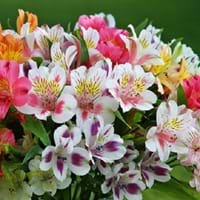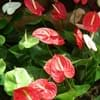Life Span
Annual
Perennial
Type
Tender Perennial
Tree
Origin
South America, Argentina, Chile
Africa, South-Eastern Asia
Types
Not Available
Not Available
Habitat
Cultivated Beds
Subtropical forests, Tropical regions
USDA Hardiness Zone
8-11
5-9
Sunset Zone
H1, 5, 6, 7, 8, 9, 14, 15, 16, 17, 18, 19, 20, 21, 22, 23, 24
1a, 1b, 2a, 2b, 3a, 3b, 7, 8, 9, 10, 11, 14, 18, 19, 20, 21
Habit
Clump-Forming
Clump-Forming
Flower Color
Light Pink, Lavender, Orange Red
Pale Yellow, Yellow green
Flower Color Modifier
Multi-Color
Bicolor
Fruit Color
Yellow green
Green, Light Green
Leaf Color in Spring
Light Green, Gray Green
Green
Leaf Color in Summer
Light Green, Gray Green
Light Green
Leaf Color in Fall
Light Green, Gray Green
Green, Light Green
Leaf Color in Winter
Gray Green, Yellow green
Brown, Light Yellow, Tan
Leaf Shape
Lanceolate
Oval
Plant Season
Summer
Summer, Fall, Winter
Sunlight
Full Sun, Partial Sun
Full Sun
Growth Rate
Medium
Medium
Type of Soil
Loam, Sand
Clay, Loam, Sand
The pH of Soil
Acidic, Neutral
Acidic, Neutral, Alkaline
Soil Drainage
Well drained
Average
Bloom Time
Early Summer, Summer, Late Summer
Summer, Late Summer, Early Fall
Tolerances
Drought
Pollution, Drought, Salt
Where to Plant?
Ground
Ground
How to Plant?
Seedlings
Seedlings, Stem Cutting
Plant Maintenance
Medium
Medium
Watering Requirements
Requires regular watering
Needs less watering
In Summer
Lots of watering
Lots of watering
In Spring
Moderate
Moderate
In Winter
Average Water
Average Water
Soil pH
Acidic, Neutral
Acidic, Neutral, Alkaline
Soil Type
Loam, Sand
Clay, Loam, Sand
Soil Drainage Capacity
Well drained
Average
Sun Exposure
Full Sun, Partial Sun
Full Sun
Pruning
Remove damaged leaves, Remove dead branches, Remove dead leaves
A hard prune may be necessary if the plant becomes woody, Cut upper 1/3 section when young to enhancegrowth, Remove damaged leaves, Remove dead branches, Remove dead leaves
Fertilizers
All-Purpose Liquid Fertilizer
10-10-10 diluted liquid fertilizer, All-Purpose Liquid Fertilizer, Compost
Pests and Diseases
Red blotch
Aphids, Downy mildew, Purple Blotch, Red blotch
Plant Tolerance
Drought
Drought, Salt and Soil Compaction, Shade areas
Flower Petal Number
Single
Single
Fragrant Bark/Stem
Not Available
No
Foliage Texture
Fine
Fine
Foliage Sheen
Matte
Glossy
Attracts
Hummingbirds
Bees, Flies, pollinators
Allergy
angioedema, Rhinoconjunctivitis, Throat itching, Urticaria
conjunctivitis, sneezing
Aesthetic Uses
Showy Purposes
Not Available
Beauty Benefits
Not Available
Making cosmetics, Not Available
Environmental Uses
Air purification
Air purification, Shadow Tree, Soil protection
Medicinal Uses
Not Available
Cardiovascular problems, Detoxifies lever, Diabetes, Dysentry, Jaundice, Menstrual Disorders
Part of Plant Used
Flowers, Root
Inner Bark, Leaf Stalks
Other Uses
Decoration Purposes
Can be made into a herbal tea, Oil is used for aromatherapy, Used as a fodder tree in agricultural areas
Used As Indoor Plant
No
No
Used As Outdoor Plant
Yes
Yes
Garden Design
Cutflower, Mixed Border
Dried Flower/Everlasting, Lawns and Turf, Mixed Border, Wildflower
Botanical Name
ALSTROEMERIA ligtu
Terminalia arjuna
Common Name
Lily-of-the-Incas, Peruvian-lily
Arjuna
In Hindi
peruvian lily
अर्जुन वृक्ष
In German
peruanische Lilie
Terminalia arjuna
In French
lis des Incas
Terminalia arjuna
In Spanish
lirio peruano
Migdałecznik arjuna
In Greek
περουβιανή κρίνος
arjuna
In Portuguese
lírio peruano
Migdałecznik arjuna
In Polish
peruwiański lilia
Migdałecznik arjuna
In Latin
Peruviani lilium
arjuna
Phylum
Magnoliophyta
Magnoliophyta
Class
Liliopsida
Not Available
Genus
Alstroemeria
Terminilia
Clade
Angiosperms, Monocots
Angiosperms, Eudicots, Rosids
Tribe
Not Available
Not Available
Subfamily
Not Available
Not Available
Importance of Peruvian-Lily and Arjuna Tree
Want to have the most appropriate plant for your garden? You might want to know the importance of Peruvian-Lily and Arjuna Tree. Basically, these two plants vary in many aspects. Compare Peruvian-Lily and Arjuna Tree as they differ in many characteristics such as their life, care, benefits, facts, etc. Every gardener must at least have the slightest clue about the plants he wants to plant in his garden. Compare their benefits, which differ in many ways like facts and uses. The medicinal use of Peruvian-Lily is Not Available whereas of Arjuna Tree is Cardiovascular problems, Detoxifies lever, Diabetes, Dysentry, Jaundice and Menstrual Disorders. Peruvian-Lily has beauty benefits as follows: Not Available while Arjuna Tree has beauty benefits as follows: Not Available.
Compare Facts of Peruvian-Lily vs Arjuna Tree
How to choose the best garden plant for your garden depending upon its facts? Here garden plant comparison will help you to solve this query. Compare the facts of Peruvian-Lily vs Arjuna Tree and know which one to choose. As garden plants have benefits and other uses, allergy is also a major drawback of plants for some people. Allergic reactions of Peruvian-Lily are angioedema, Rhinoconjunctivitis, Throat itching and Urticaria whereas of Arjuna Tree have conjunctivitis and sneezing respectively. Having a fruit bearing plant in your garden can be a plus point of your garden. Peruvian-Lily has no showy fruits and Arjuna Tree has showy fruits. Also Peruvian-Lily is not flowering and Arjuna Tree is not flowering . You can compare Peruvian-Lily and Arjuna Tree facts and facts of other plants too.





